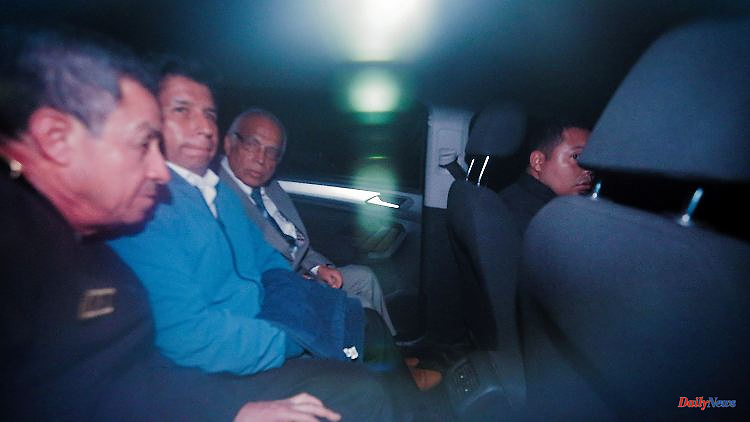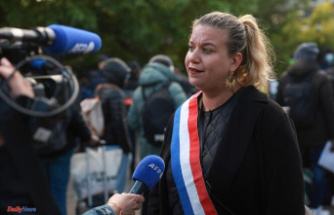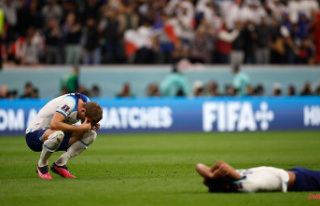The teacher from the country came to Lima to fight poverty as president: Pedro Castillo. He left in handcuffs as a failed putschist. Peru's heads of state have almost handed each other over the past few years. The problems lie deeper.
The grand finale of the Peruvian presidential drama would have fitted into an overly long movie. On Wednesday, Congress wanted to hold a vote to remove President Pedro Castillo. He ordered the dissolution of parliament, wanted to set up an emergency government, set up the judiciary differently and have a new constitution drawn up. But the military and police refused to support him, Congress removed Castillo from office for "permanent moral incompetence" and swiftly sworn in the previous Vice President, Dina Boluarte. Castillo had already been arrested for an attempted coup.
A constituent assembly is illegal without the approval of Congress, so Castillo's actions in Peru have been classified as a coup d'état. Street battles in front of Congress and elsewhere in the country followed his ouster, and the Pan-American Highway and other major transport arteries of Peru remain blocked. In polls, a large majority also calls for the dissolution of parliament and new elections. Castillo continues to enjoy support, especially in rural areas. It shattered against itself, but also against old power structures.
Peru is rich in mineral resources, has vast rainforests, a long coastline for fishing and an impressive cultural history. And yet the South American country on the Pacific plunges into chaos again and again. Political crises of a similar magnitude have shaken it several times in recent years. The country has had six heads of state since 2016, none of whom ended their mandate. Several are in prison for corruption, others are still under investigation. The problem is also in the system.
The plans of the head of state, who himself comes from one of the poorest regions of the country, to fight poverty in rural Peru, to transform the economy and to have a new constitution drawn up, have all failed. "There hasn't been an economic shift to the left, as Castillo had promised," says Peruvian human rights lawyer Ana Vidal. "Nothing has changed compared to the previous governments." He didn't do politics for the citizens - or couldn't do it.
With Castillo's dismissal, the Peruvian experiment also came to an end, whereby a politician from the outside, without knowledge of the cliques and power structures in the capital, could achieve more than his predecessor. "Without experience, he couldn't find his way in the jungle of Peruvian politics, which is determined by the elite," says Robert Helbig of the Konrad Adenauer Foundation in Lima. "It was the best possible situation for the existing power structures. His presidency did nothing for the population."
Castillo entered the runoff election for the presidency with only 18.4 percent; he did not have a majority in the single-chamber Congress from the start. The teacher and trade unionist was the first left-wing president in decades - at least on paper. Castillo was an "invited" presidential candidate for the leftist Peru Libre party, not uncommon in Peruvian politics.
Individuals are often more popular than parties, which hope to gain more influence. For example, entrepreneurs can exert direct political influence. The population's trust in their parliament is correspondingly low: Shortly before Castillo's dismissal, only 11 percent approved it, at the same time 87 percent were already calling for new elections. This also seems attractive to the vast majority because MPs are only allowed one term of office. Unwelcome MPs can be dismissed by new elections.
"Castillo should have negotiated laws with the opposition, but that didn't happen," says Helbig. "The projects in the transport and education sectors instead came from there and served their private interests." Many of the party leaders earned money in the private education sector and could now earn even more because they no longer have to meet quality criteria, says Helbig. "This is a big step backwards for Peruvian society."
In rural areas, support for Castillo was last at 45 percent, with an upward trend and little less than a year ago. In the capital Lima it was only 19 percent. All this is taking place in a crisis of the economic model based on commodity exports. Inflation is driving people into malnutrition, in the vast rural regions of the centralized country there is a lack of infrastructure such as roads, hospitals and schools, and industry everywhere.
The ex-president is much more popular among low-income Peruvians than among the middle class or the wealthy. The man in the big-brimmed hat was a political outsider. With his election in 2021, Castillo gave the population outside of the elite capital Lima new hope to finally experience more than the tedious power struggle of the elite, while nothing changes for them. "No more poor in a rich country" was one of his campaign slogans.
Not without reason, since the countermeasures to the pandemic had left a third of the population below the poverty line, an increase of 50 percent. Inflation has been lashing out at the low-income population for the past year, and it's at its highest level in a quarter of a century. Various staple food prices have more than doubled. Investments flow mainly through mining companies in their own sector, further profits usually flow back abroad. The people in Peru lack the skills to move up into the middle class.
According to a study by the aid organization "Acción Contra el Hambre", 80 percent of Peruvians in the Lima area suffer from food insecurity and had to change their eating habits this year due to lack of money. A third of the population lives in the metropolitan area of the capital. According to the United Nations, more than half of the people across the country have a forced malnutrition. State institutions are also partly to blame.
During his tenure, Castillo never got around to dealing with the country's problems in a structured way. He constantly exchanged members of the government; including allegations of corruption related to public works contracts, domestic violence and even murder. In his roughly one-and-a-half years in office, he exhausted more than 80 ministers. Peru Libre excluded the president from the party months ago, and he had fewer and fewer allies. He was recently accused of taking millions of dollars in bribes.
Castillo's radical final moves to regain the initiative fatally resembled those of ex-President Alberto Fujimori, who similarly elevated himself to dictatorship in 1992. Castillo also won the election for this reason: His opponent was Fujimori's daughter Keiko, who is a bloody rag for large parts of the population. Her father is in prison for, among other things, human rights crimes; for massacres, death squads and forced sterilization of women.
Former teacher Castillo is now in custody, in the same prison as Fujimori. Castillo came from the other Peru, was the first to make it into the presidential palace with his anti-elite course. But he still couldn't change the balance of power. "Here, the forces that have been doing this for hundreds of years continue to rule," says Helbig: "The elite of Lima."












